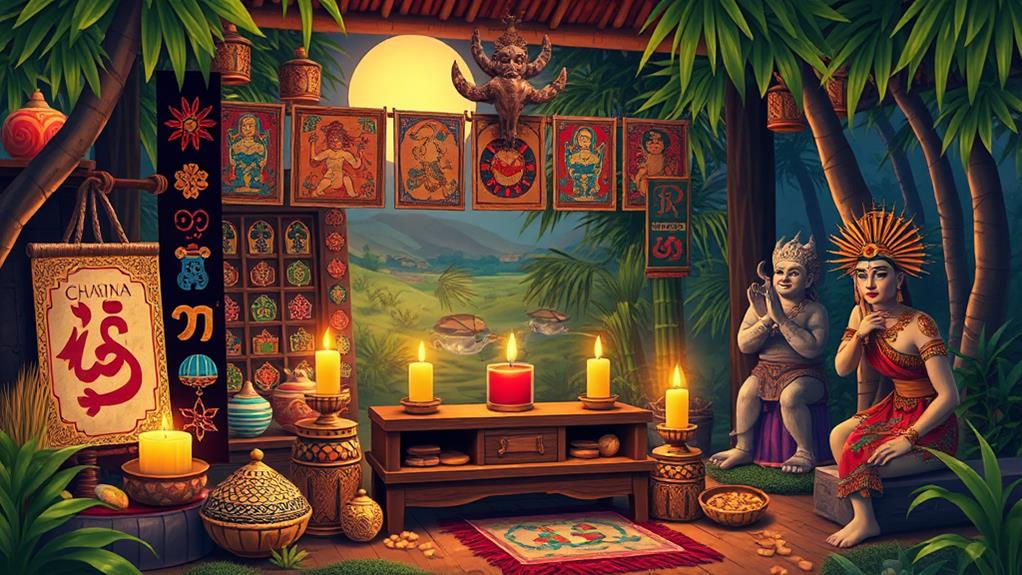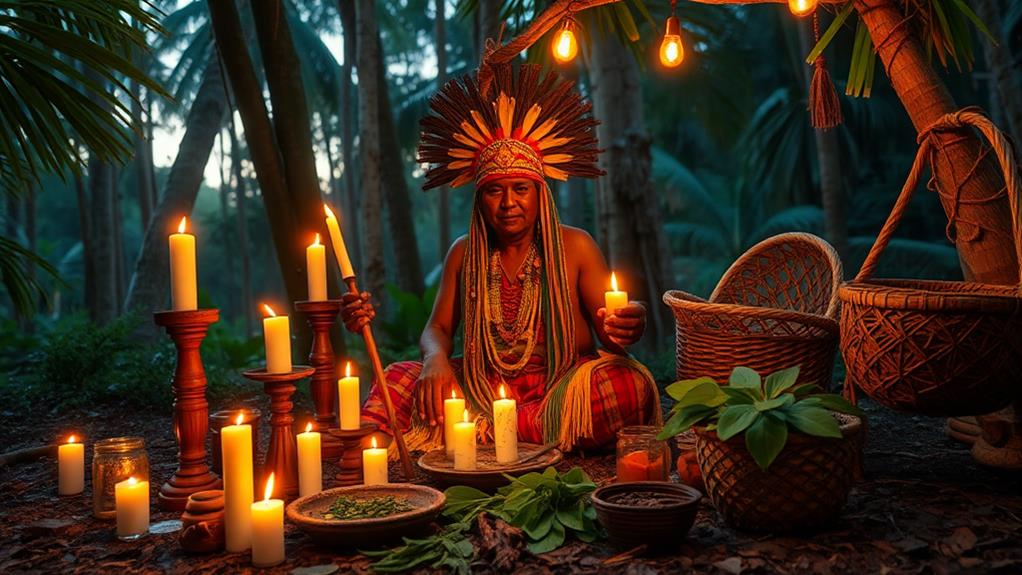Filipino folklore is a rich blend of ancient animism and colonial history. This mix of influences is reflected in the country's diverse superstitions and beliefs. For instance, many Filipinos believe that sweeping the floor at night can sweep away good fortune, while an itchy palm is thought to be a sign of incoming money.
Folklore creatures, such as the kapre and the tikbalang, add a touch of mystery to daily life. The kapre is a friendly creature, often depicted as a small, bearded man who loves to play tricks on humans. On the other hand, the tikbalang is a mischievous creature known for playing tricks on travelers.
Rituals associated with meals and healing are deeply rooted in cultural values. For example, the phrase "Oro, plata, mata" is often recited during meals to ensure good fortune and respect for the community.
These traditions not only shape individual lives but also create a unique cultural identity that is worth exploring further.
Overview of Filipino Superstitions

Filipino superstitions are deeply rooted in daily life, influencing actions and decisions. These superstitions are a blend of indigenous animism and colonial history, passed down through generations. They often blur the line between the religious and the superstitious, with many believing that certain actions can attract good luck or ward off bad luck.
Avoiding nighttime sweeping or singing is a common practice to prevent disturbing spirits and misfortune. This belief is based on the idea that spirits are most active at night, and any loud noises or disturbances can attract negative energy.
Meals are rich in ritual and superstition. For instance, chanting "Oro, plata, mata" while climbing stairs is believed to influence one's fortune. Additionally, turning plates when guests leave ensures their safe return. These practices demonstrate the significance of superstition in everyday activities.
Child care is also influenced by superstitions. The concept of usog or bati warns that compliments can inadvertently harm infants, highlighting the community's protective instincts. This belief emphasizes the importance of being mindful of one's words and actions around young children.
Rituals and offerings are dedicated to spirits during significant life events. For example, the practice of pagpag serves to prevent spirits from following you home. This reflects the deep-rooted concerns about the unseen world in Filipino folklore.
These superstitions offer a glimpse into the collective psyche, illustrating how culture shapes perceptions of luck and protection.
Common Folklore Creatures
Filipino folklore is rich in supernatural beings that reflect local beliefs and stories. These creatures often serve as cautionary tales or representations of cultural values.
Kapre is a tall, dark tree-dweller who smokes cigars and can be either friendly or mischievous.
Tikbalang is a horse-like entity with human features that leads travelers astray in the woods.
Tiyanak appears as an unborn baby to lure victims, only to reveal its true form later.
Nuno sa punso are small, dwarf-like beings that inhabit mounds or anthills. It's customary to say "tabi tabi po" to seek their permission when passing by.
Aswang is a fearsome shape-shifter that preys on pregnant women and children, taking on various frightening forms.
These folklore creatures embody the mysteries of nature and the complexities of human experience, highlighting the thin line between reality and the supernatural.
Rituals and Healing Practices

Rituals and Healing Practices in Filipino Culture
In the Filipino culture, rituals and healing practices play a significant role in bridging the physical and spiritual realms. Albularyos, or folk healers, lead these practices, using herbs, rituals, and prayers to address ailments. In rural areas, communities heavily rely on these methods, reflecting their deep-rooted beliefs in the supernatural.
Healing Rituals
Healing rituals involve specific practices to connect with good spirits and amplify healing powers. For instance, candle-lighting and specific prayers are used to enhance the connection with good spirits. These rituals not only address physical ailments but also seek to balance spiritual energies.
Dark Aspects of Filipino Healing
The Filipino healing realm also has darker aspects. Pagkukulam, or the casting of spells, reveals the belief in black magic's influence over people's lives. This often involves using voodoo dolls to manifest curses.
On the other hand, gayuma, or love potions, demonstrates how love and magic intertwine, showcasing the complexity of emotional desires within rituals.
Reflection of Filipino Worldview
These practices reflect the unique worldview of the Filipino people, highlighting their intricate relationship with the seen and unseen. By exploring these rich traditions, it becomes clear how they address not only physical ailments but also spiritual imbalances.
How Do Filipino Folklore Superstitions and Beliefs Impact the Future of Religion in the Philippines?
Filipino folklore superstitions and beliefs continue to play a significant role in shaping the future of religion in the Philippines. These deeply-rooted cultural customs and traditions directly influence the way religion is practiced and interpreted in the country, impacting the future of religion philippines.
Superstitions in Daily Life
Superstitions shape daily interactions in Filipino culture, influencing decisions and actions.
In Filipino culture, superstitions play a significant role in guiding daily interactions. Sweeping at night is believed to bring bad luck, as it's thought to drive away fortune instead of cleaning. This belief is deeply ingrained, and many Filipinos avoid sweeping at night to prevent misfortune.
Physical sensations can also be omens of good or bad luck. For instance, an itchy right palm is believed to signal incoming money, while an itchy left palm forebodes financial loss.
The first customer of the day is considered crucial for business success. To ensure favorable outcomes, discounts are often offered to the first customer, known as "buenamano", to attract good luck.
Certain practices are believed to ward off mischievous beings. For example, leaving clothes out overnight may attract "duende", mischievous beings that could tamper with belongings. To prevent this, many Filipinos avoid leaving clothes out overnight.
Turning plates upside down when someone leaves the table is believed to ensure their safe return. This practice is a common superstition in Filipino culture, reflecting a deep-rooted connection to the unseen forces at play in daily life.
In Filipino culture, superstitions serve as a reminder of the respect for the unseen influences that shape existence. These beliefs are often consulted with an albularyo, a local healer, to navigate the complexities of luck and misfortune.
Cultural Significance of Beliefs

Beliefs in Filipino folklore significantly influence daily life and cultural values. For example, when a pregnant woman walks in nature, saying "tabi tabi po" is a respectful acknowledgment of the spirits that might inhabit the area. This practice showcases a deep-rooted respect for both the seen and unseen, highlighting the belief that evil spirits could disrupt harmony.
Filipinos believe superstitions are essential for maintaining safety and well-being. These beliefs are widely practiced during critical life events, such as birth, marriage, and death, fostering community bonds as families gather to observe rituals.
For instance, when an immediate family member passes away, rituals that respect the spirit and the living are performed, demonstrating the interconnectedness of life and death in Filipino culture.
Traditional beliefs integrate with modern practices, ensuring cultural identity remains strong. The role of the albularyo (folk healer) exemplifies this integration.
These superstitions emphasize the importance of community, respect for tradition, and the synthesis of indigenous and Christian beliefs, enriching the Filipino cultural tapestry and ensuring continuity through shared values.
Questions and Answers
What Are Some Superstitious Beliefs in the Philippines?
Superstitious beliefs play a significant role in shaping daily life in the Philippines. These beliefs stem from folk traditions with deep historical origins and vary across regions.
In some areas, people avoid sweeping at night because they believe it can bring misfortune. Another example is the ritual of saying "pwera usog" to counter negative energy when complimenting babies, which is a common practice in Filipino culture.
These beliefs continue to influence social interactions and personal choices, often blending traditional and modern interpretations.
What Are the 10 Superstitious Beliefs?
Superstitious Beliefs: 10 Intriguing Concepts
1. Luck Charms
Luck charms, such as four-leaf clovers or horseshoes, are believed to bring protection or fortune.
For example, carrying a rabbit's foot is thought to attract good luck.
2. Ghost Sightings
Ghost sightings are often associated with supernatural beings or spirits.
The Amityville Horror, a famous haunted house, is a well-known example of a ghost sighting.
3. Friday the 13th
Friday the 13th is considered an unlucky day, with many people avoiding important decisions or events on this day.
4. Wishing Wells
Wishing wells, like those found in European towns, are believed to grant wishes to those who throw coins into them.
5. Animal Omens
Animal omens, such as black cats or owls, are thought to convey messages or warnings from the universe.
For instance, seeing a dove is often seen as a symbol of peace.
6. Wedding Rituals
Wedding rituals, like exchanging vows or wearing white, are steeped in tradition and reflect cultural values.
7. Dream Interpretations
Dream interpretations, such as Freudian analysis, offer insight into one's subconscious mind.
8. Healing Practices
Healing practices, such as acupuncture or meditation, emphasize holistic well-being and natural remedies.
9. Broken Mirrors
Breaking a mirror is believed to bring seven years of bad luck, according to an old superstition.
10. Knocking on Wood
Knocking on wood is a common superstition believed to ward off bad luck or evil spirits.
Each of these superstitious beliefs weaves a rich tapestry of human experience and connection.
What Are Examples of Beliefs in the Philippines?
Ancestral spirits are revered in the Philippines, often influencing festive rituals and ancestral veneration practices.
For example, the Igorot people in the northern Philippines celebrate the Pangkabayo festival, where they honor their ancestors through traditional dances and offerings.
Nature worship is also prevalent, with herbal remedies used for healing.
In many Filipino communities, medicinal plants like lagundi and sambong are used to treat various ailments, showcasing the connection to nature.
Sacred places hold significant meaning in the Philippines.
The Taytay Falls, for instance, is considered a sacred site by the indigenous Mangyan people, who believe it holds spiritual power.
Folk tales and dream interpretations enrich daily life.
In many Filipino families, stories of mythical creatures like the aswang and diwata are passed down through generations, teaching moral lessons and values.
Similarly, dreams are often interpreted to guide decision-making and provide insight into the future.
What Are the Old Beliefs of the Philippines?
The Philippines' old beliefs revolve around nature spirits and mythical creatures.
In ancient rituals, Filipinos honored these supernatural beings to ensure a harmonious relationship with the environment. For instance, the Tagalog people believed in Diwata, a forest spirit who protected the forest and its inhabitants.
Similarly, the Tinikling, a mythical bird, was believed to possess healing powers.
Folk healing practices are deeply rooted in traditional customs.
These practices emphasize the connection between the community and their ancestors. In many Filipino communities, albularyos (traditional healers) use a combination of herbal remedies, rituals, and prayers to cure illnesses.
They believe that the ancestors' spirits guide them in the healing process.
Ancestral worship plays a significant role in harvest festivals and community gatherings.
During these celebrations, people express gratitude to their ancestors for bountiful crops. For example, the Pintados Festival in Leyte honors the ancestors with vibrant costumes, music, and dance.
The festival highlights the importance of respecting and honoring one's heritage.
These beliefs reflect a deep respect for the environment and the interconnectedness of life.
They shape the Filipino cultural identity by emphasizing the need to live in harmony with nature and the community.